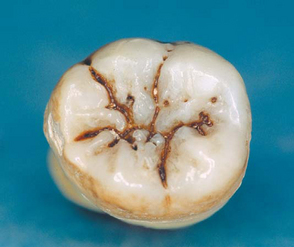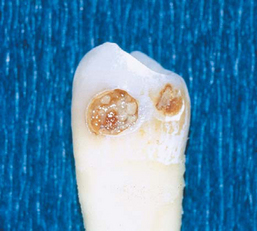CHAPTER 18 Restorative or Operative Dentistry
Fillings for Teeth
The most common and well known treatment accomplished in the general dentist’s office is filling or restoring teeth. Although restoration (filling) of teeth involves a significant amount of time in many general practices, you are learning from this book that dentists do far more than restore teeth. However, dental caries (decay) is still common in most parts of the world, and the routine restoration of teeth continues to be a significant part of dentistry. In developing countries, dental caries among children is high. Less dental caries is present in children in developed countries, where the disease has shifted to the other end of life in the now long-lived mature population. Dental caries has long been the most prevalent of all oral diseases, and you probably have some restorations (fillings) in your teeth. Chapter 19 tells you how to prevent this common disease relatively easily.
Dental caries usually develops in the grooves found on the chewing surfaces of the teeth or between the teeth, but the breakdown of tooth surfaces can occur in any location on teeth where food debris is left routinely (FIG. 18.1). Dental caries is not painful at first, but when pain is present while eating cold foods, sugar, or other stimulation, the degenerative process has progressed to a location close to the pulp (nerve) of the tooth. Treatment must be accomplished immediately to save the tooth. Accidents can also cause breakage of the tooth, requiring restoration similar to that required for dental caries.
Tooth restorations will serve for many years if the dental caries has been treated when it is small and the restoration is similarly small. Longevity estimates are made for each type of restoration later in this chapter.
WHAT YOU SEE OR FEEL
Conditions, Signs, or Symptoms Related to Restorative or Operative Dentistry
1. Tooth Is Sensitive to Sweets
Anything that contains sugar, including fruit sugars, causes a sharp, continuing pain from a specific tooth site. This pain usually diminishes over time, or if you rinse well with warm (body temperature) water. Pain caused by sweet foods usually indicates that dental caries (decay) has progressed to a point that it is near the dental pulp (nerve) of the tooth, and you need to seek professional care immediately to reduce the chances of more serious tooth damage, which might require root canal therapy. Depending on the size and depth of the dental caries (decay) in your tooth, one of the described types of restorations (fillings) will usually solve the problem (p. 170).
2. Tooth Is Sensitive to Cold
Ice cream, cold drinks, and other cold foods or drinks cause pain from a specific tooth location. Warming the tooth up reduces the pain. Deep dental caries (decay) often causes sensitivity to cold. Depending on the size and depth of the dental caries in your tooth, one of the described types of restorations (fillings) will usually solve the problem (p. 170).
3. Tooth Is Sensitive to Heat
Hot foods or drinks cause pain for a substantial period or until the tooth reaches body temperature again. This symptom is usually not related to dental caries (decay) but is related most often to a dead or dying dental pulp (nerve) that may require endodontics (root canal therapy) (p. 40).
4. Tooth Is Sensitive to Pressure
Sensitivity to pressure usually indicates a dead or dying dental pulp (nerve) that requires endodontics (root canal therapy) (p. 40). However, occasionally, impacted food and/or a sweet object in a decayed tooth can cause pain on pressure. Your dentist can tell for sure.
5. Hole in Tooth
Dental caries (decay) starts slowly on the outside surface of a tooth (FIG. 18.2). Often, only a small external hole develops, while the internal portion of the tooth is hollow. The weakened external enamel shell then breaks away, exposing debris and discoloration in the underlying tooth structure. Such a decayed tooth usually requires immediate professional attention to reduce the chance of the need for endodontics (root canal therapy). Depending on the size and depth of the dental caries in your tooth, one of the described types of restorations (fillings) will usually solve the problem (p. 170).
6. Tooth Restoration (Filling) Has Fallen Out
(FIG. 18.3). Most dentists place restorations that have good retention to the tooth structure, and it is unlikely that a restoration will fall out by itself. Sometimes, new decay begins around the edges of a restoration, undermining it and reducing its retention in the remaining tooth structure. As a result, the restoration becomes loose and may eventually fall out. A restoration that comes out usually indicates that the tooth has a significant amount of dental caries (decay) and requires immediate professional care. However, sticky foods such as caramels can pull a restoration out of a tooth. Depending on the size and depth of the decay in your tooth, one of the described types of restorations (fillings) will usually solve the problem (p. 170).
7. Restoration (Filling) Is Loose But Has Not Come Out
Occasionally, restorations (fillings) break, or the tooth structure around them decays further, and a restoration becomes loose in the tooth. This is an especially dangerous condition because the tooth structure cannot be cleaned well. Stagnant food debris and oral plaque collect below the loose restoration, and new decay progresses rapidly. Immediate professional care is mandatory, or the tooth will require endodontics (root canal therapy). Depending on the size and depth of the dental caries (decay), one of the described types of restoration will usually solve the problem (p. 170).
8. Bad Taste Comes From a Tooth When Sucking on It
Dental caries (decay) in an unfilled tooth, or under an existing restoration (filling), collects food debris and degenerating tooth structure, and the result is a foul taste and odor. Dental caries this deep requires immediate professional care. Depending on the size and depth of the dental caries in your tooth, one of the described types of restorations will usually solve the problem (p. 170).
Stay updated, free dental videos. Join our Telegram channel

VIDEdental - Online dental courses





